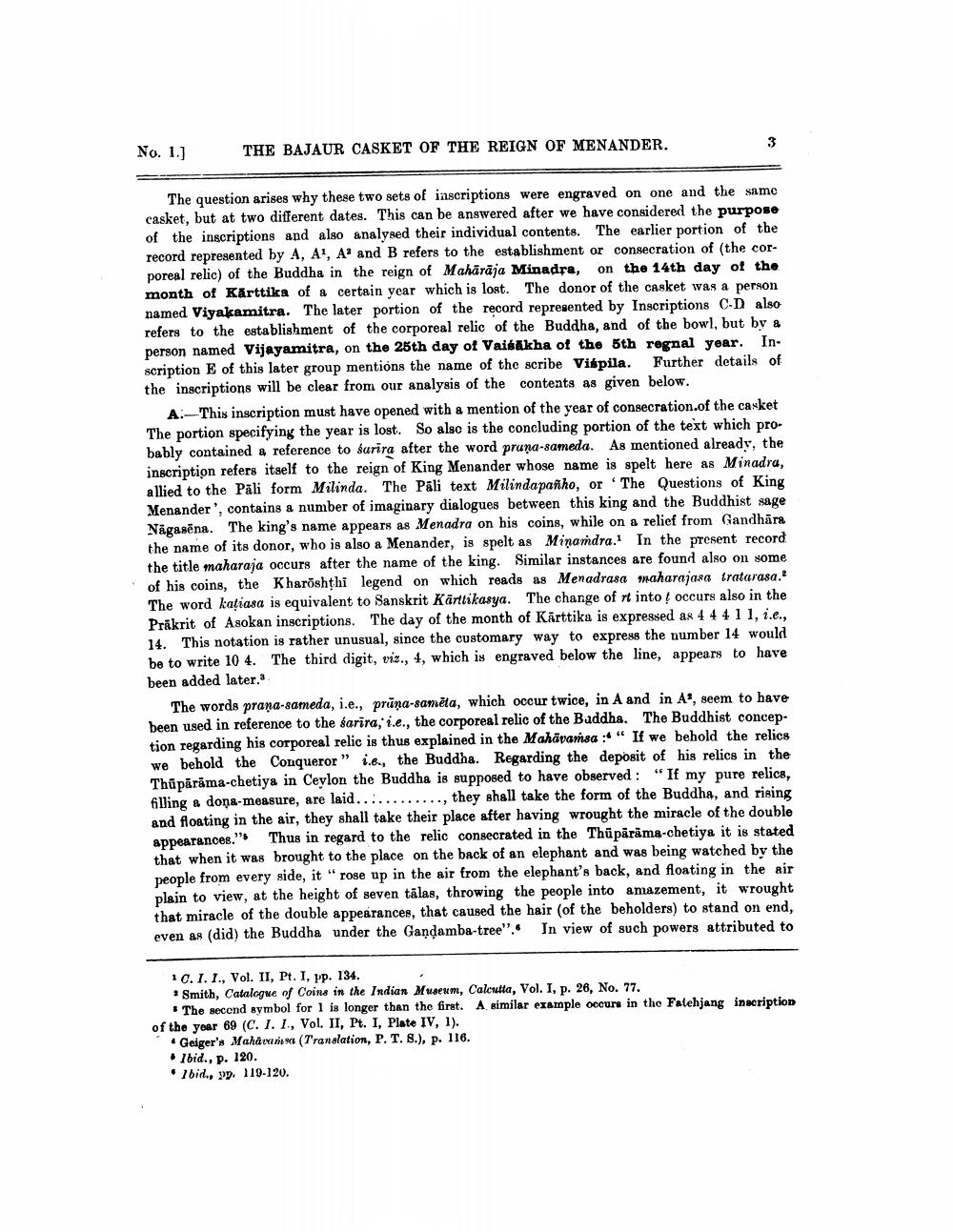________________
No. 1.]
THE BAJAUR CASKET OF THE REIGN OF MENANDER.
The question arises why these two sets of inscriptions were engraved on one and the same casket, but at two different dates. This can be answered after we have considered the purpose of the inscriptions and also analysed their individual contents. The earlier portion of the record represented by A, A', A and B refers to the establishment or consecration of the corporeal relic) of the Buddha in the reign of Mahārāja Minadra, on the 14th day of the month of Kārttika of a certain year which is lost. The donor of the casket was a person named Viyakamitra. The later portion of the record represented by Inscriptions C-D also refers to the establishment of the corporeal relic of the Buddha, and of the bowl, but by & person named Vijayamitra, on the 25th day of Vaisakha of the 5th regnal year. Inscription E of this later group mentions the name of the scribe Viśpila Further details of the inscriptions will be clear from our analysis of the contents as given below.
A.-This inscription must have opened with a mention of the year of consecration.of the casket The portion specifying the year is lost. So also is the concluding portion of the text which probably contained a reference to sarira after the word pruna-sameda. As mentioned already, the inscription refers itself to the reign of King Menander whose name is spelt here as Minadra, allied to the Pāli form Milinda. The Pali text Milindapanho, or The Questions of King Menander', contains a number of imaginary dialogues between this king and the Buddhist sage Nägasēna. The king's name appears as Menadra on his coins, while on a relief from Gandhāra the name of its donor, who is also a Menander, is spelt as Minamdra. In the present record the title maharaja occurs after the name of the king. Similar instances are found also on some of his coins, the Kharoshthi legend on which reads as Menadrasa maharajara tratarasa. The word katiasa is equivalent to Sanskrit Karttikasya. The change of rt into occurs also in the Prākrit of Asokan inscriptions. The day of the month of Kärttika is expressed as 4 4 411, i.e., 14. This notation is rather unusual, since the customary way to express the number 14 would be to write 10 4. The third digit, viz., 4, which is engraved below the line, appears to have been added later.
The words prana-sameda, i.e., prūna-samēta, which occur twice, in A and in A!, seem to have been used in reference to the sarira, i.e., the corporeal relic of the Buddha. The Buddhist conception regarding his corporeal relic is thus explained in the Mahāvansa : " If we behold the relics we behold the Conqueror " i.e., the Buddha. Regarding the deposit of his relics in the Thũpărāma-chetiya in Ceylon the Buddha is supposed to have observed : "If my pure relics, filling a dona-measure, are laid............, they shall take the form of the Buddha, and rising and floating in the air, they shall take their place after having wrought the miracle of the double appearances." Thus in regard to the relic consecrated in the Thüpārāma-chetiya it is stated that when it was brought to the place on the back of an elephant and was being watched by the people from every side, it "rose up in the air from the elephant's back, and floating in the air plain to view, at the height of seven tālas, throwing the people into amazement, it wrought that miracle of the double appearances, that caused the hair (of the beholders) to stand on end, even as (did) the Buddha under the Gandamba-tree". In view of such powers attributed to
10. 1. 1., Vol. II, Pt. I, pp. 134.
Smith. Catalogue of Coins in the Indian Museum, Calcutta, Vol. I, p. 26, No. 77.
• The second symbol for 1 is longer than the first. A similar example occurs in the Fatehjang inscription of the year 69 (C. I. I., Vol. II, Pt. I, Plate IV, 1).
Geiger's Mahavirus (Translation, P. T. 8.), p. 116. . Ibid., p. 120. . Ibid., p. 119-120.




